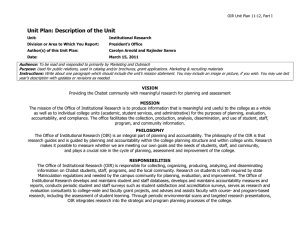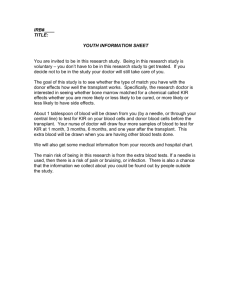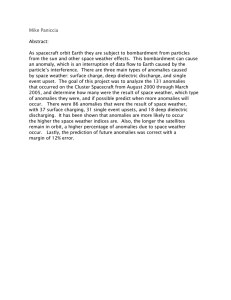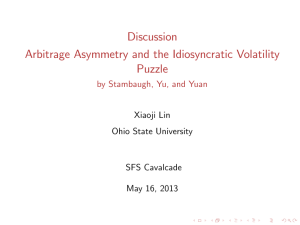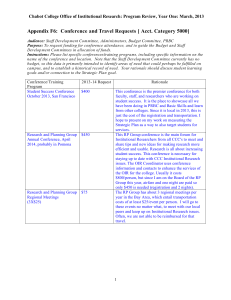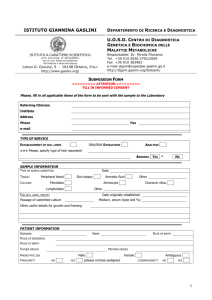MISPRICING FACTORS Robert F. Stambaugh Yu Yuan Wharton and NBER
advertisement
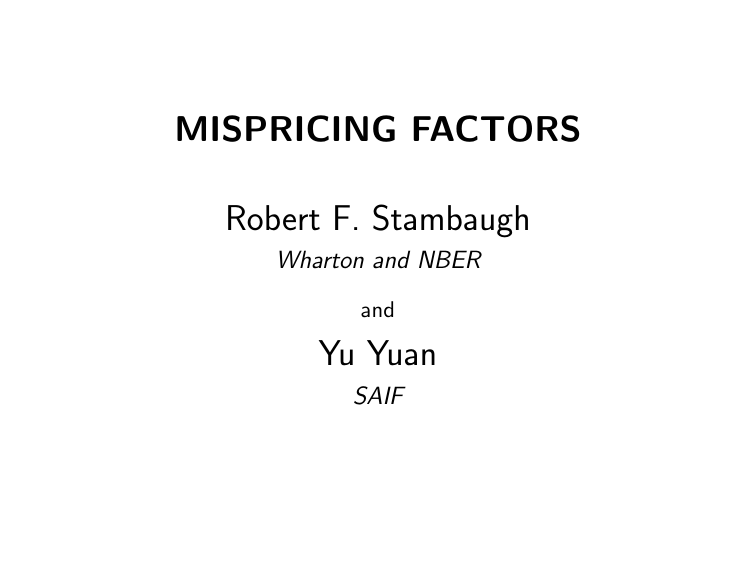
MISPRICING FACTORS
Robert F. Stambaugh
Wharton and NBER
and
Yu Yuan
SAIF
Factor Origins
• Factors: the fj,t ’s in
ri,t = ai +
K
X
βij fj,t + i,t
j=1
• Originated without prior evidence of role in average return
• market, consumption, output, volatility, liquidity, inflation, etc.
• factors extracted using principal components or factor analysis
• Originated with prior evidence of role in average return
• size, value, momentum
• investment, profitability
• Factors based on the second approach are more popular
• they explain expected returns better
• “theory is flexible” (SG)
• We also pursue the second approach
• exploiting more of the evidence
• maintaining parsimony—key virtue of factor models
Motivation: Anomalies and Mispricing
• Anomalies
• Mispricing effects (large literature)
• Systematic components (e.g., investor sentiment)
• Recent evidence examining multiple anomalies:
• Sentiment predicts anomaly long-short profits
• Short-leg returns are especially low following high sentiment
• Short-leg returns are stronger among stocks less easily shorted
• IVOL is positively (negatively) related to long-leg (short-leg)
alphas
• Short-leg negative IVOL effect is stronger
• among stocks less easily shorted
• following high sentiment
• Following publication of an anomaly
• greater trading activity in its portfolios
• lower profits
E.g., Baker and Wurgler (2006), Stambaugh, Yu, and Yuan (2012,
2015), Drechsler and Drechsler (2014), McLean and Pontiff (2015)
Factors: Our Approach
• Our factors aggregate information in 11 prominent anomalies
• same set used in Stambaugh, Yu, and Yuan (2012, 2014, 2015)
• alleviate data-mining concerns
• examine model performance on wide range of other anomalies
• Objective: capture systematic components of mispricing
• Factor models can capture systematic risk or mispricing
• Parsimonious alternative to popular single-anomaly factors
• Four-factor model:
• market
• size (SMB)
• two “mispricing factors” (MGMT and PERF )
• Three-factor model:
• market
• size (SMB)
• one mispricing factors (UMO)
Main Results
• Our four-factor model
• accommodates a wide range of anomalies better than notable
4- and 5-factor alternatives.
• is heavily favored in Bayesian factor-model comparisons
• Our version of SMB implies a substantially larger size
premium.
• constructed to minimize the effects of mispricing
• our SMB averages 46 bps (per month)
• versus 25 bps for the Fama-French three-factor SMB
• Our 3-factor model also performs well, especially in the
Bayesian model comparisons.
• Shared limitation of the factor models we consider:
• cannot accommodate IVOL-related alpha
• evident when controlling for overpricing vs. underpricing
• otherwise can appear as successfully handling IVOL
• effect of arbitrage risk enters depends on mispricing direction
Constructing the Mispricing Factors
• Universe: NYSE/AMEX/NASDAQ stocks, price ≥ $5
• Correlations of 11 anomaly long-short return residuals in
regression
Rit = αi + βi MKTt + si SMBt + it
• Two clusters - Ahn, Conrad, Dittmar (2009) procedure
First Cluster
Net stock issues
Composite equity issues
Accruals
Net operating assets
Asset growth
Investment-to-assets
Second Cluster
Distress
O-score
Momentum
Gross profitability
Return on assets
• First cluster, MGMT : management-related
• Second cluster, PERF : performance-related
Constructing the Mispricing Factors
• Average each stock’s anomaly percentiles within each cluster
→ mispricing measures P1 and P2
• Separate small and large stocks, using median NYSE size
• Within each size group, form two value-weighted portfolios:
• stocks with P1 below 20th NYSE/AMEX/NASDAQ pctile
• stocks with P1 above 80th NYSE/AMEX/NASDAQ pctile
• MGMT : average low-P1 return minus average high-P1 return
• PERF : same procedure using P2
Size Factor
• Our SMB:
• use only the stocks not used in the mispricing factors
• return difference between value-weighted portfolios of
• small stocks not in the four extreme P1 and P2 portfolios
• large stocks not in the four extreme P1 and P2 portfolios
• Alternative (more familiar) procedure:
• use all stocks
• return difference between value-weighted portfolios of
• average of all six small-stock P1 and P2 portfolios
• average of all six large-stock P1 and P2 portfolios
• mispricing effects unlikely to average out
• arbitrage asymmetry ⇒ over-pricing more severe
• especially for small stocks
• result: downward bias in size premium
• Important for size premium
• Not important for our model’s ability to explain anomalies
Comparing Size Premia
• Size premia, bps per month, 1967–2013
1. Our SMB
2. Alternative SMB
3. FF-3 SMB
1 minus 2
1 minus 3
Average
46.0
27.5
24.7
18.4
21.3
t-statistic
3.76
2.30
1.86
3.99
4.19
• Is book/market affected by mispricing? (e.g., Lakonishok,
Shleifer, Vishny (1994))
• Size matters after controlling for mispricing
. . . or, “if you control your junk” (Asness et al. (2015))
Factors: Monthly Statistics
Factor
MGMT
PERF
SMB
MKT
Mean(%)
0.62
0.70
0.46
0.51
Std. Dev.(%)
2.93
3.83
2.90
4.60
MGMT
1
0.00
-0.30
-0.55
Correlations
PERF SMB
0.00
-0.30
1
-0.06
-0.06
1
-0.25
0.26
MKT
-0.55
-0.25
0.26
1
Factors: Monthly Statistics, 1/1967–6/1990
Factor
MGMT
PERF
SMB
MKT
Mean(%)
0.69
0.68
0.54
0.39
Std. Dev.(%)
2.76
3.01
3.02
4.79
MGMT
1.00
-0.23
-0.32
-0.63
Correlations
PERF SMB
-0.23 -0.32
1.00
-0.07
-0.07
1.00
0.01
0.32
MKT
-0.63
0.01
0.32
1.00
Factors: Monthly Statistics, 7/1990–12/2013
Factor
MGMT
PERF
SMB
MKT
Mean(%)
0.55
0.72
0.38
0.63
Std. Dev.(%)
3.10
4.50
2.78
4.40
MGMT
1.00
0.13
-0.28
-0.49
Correlations
PERF SMB
0.13
-0.28
1.00
-0.05
-0.05
1.00
-0.45
0.18
MKT
-0.49
-0.45
0.18
1.00
Factor Loadings of Anomaly Strategies, Long–Short
βMGMT
βPERF
First Cluster (used to construct mispricing factor
Net stock issues
0.63
0.22
Composite equity issues
0.85
0.05
Accruals
0.38
0.02
Net operating assets
0.46
-0.01
Asset growth
0.94
-0.02
Investment-to-assets
0.64
-0.09
Average
0.65
0.03
tMGMT
tPERF
MGMT )
17.21
8.85
18.12
1.72
6.09
0.48
8.54 -0.28
15.99 -0.54
11.83 -2.61
12.96
1.27
Second Cluster (used to construct mispricing factor PERF )
Distress
0.31
1.17
3.96 24.10
O-score
-0.09
0.23
-1.39
5.02
Momentum
0.25
1.21
1.71 12.15
Gross profitability
-0.32
0.66
-6.08 18.04
Return on assets
0.06
0.66
0.95 13.21
Average
0.04
0.79
-0.17 14.50
Factor Loadings of Anomaly Strategies, Long Legs
βMGMT
βPERF
tMGMT
tPERF
First Cluster (used to construct mispricing factor MGMT )
Net stock issues
0.31
0.06
14.29
4.18
Composite equity issues
0.48
-0.06
11.13 -2.31
Accruals
-0.22
0.08
-4.64
2.37
Net operating assets
0.09
-0.08
2.49 -2.92
Asset growth
0.34
-0.01
6.99 -0.18
Investment-to-assets
0.17
0.02
5.52
0.83
Average
0.20
0.00
5.96
0.33
Second Cluster (used to construct mispricing factor PERF )
Distress
0.04
0.39
0.78 12.27
O-score
-0.32
0.14
-6.62
4.26
Momentum
-0.18
0.46
-2.40
9.48
Gross profitability
-0.01
0.24
-0.29
7.14
Return on assets
-0.25
0.27
-7.25 10.94
Average
-0.14
0.30
-3.16
8.82
Factor Loadings of Anomaly Strategies, Short Legs
βMGMT
βPERF
First Cluster (used to construct mispricing factor
Net stock issues
-0.32
-0.16
Composite equity issues
-0.37
-0.11
Accruals
-0.61
0.06
Net operating assets
-0.37
-0.07
Asset growth
-0.60
0.01
Investment-to-assets
-0.47
0.11
Average
-0.46
-0.03
tMGMT
MGMT )
-8.82
-11.80
-16.11
-11.45
-20.20
-9.14
-12.92
tPERF
-6.62
-5.11
2.43
-2.80
0.77
3.21
-1.35
Second Cluster (used to construct mispricing factor PERF )
Distress
-0.27
-0.78
-4.67 -23.10
O-score
-0.23
-0.10
-5.14
-3.05
Momentum
-0.43
-0.75
-4.91 -12.39
Gross profitability
0.31
-0.42
5.94 -13.00
Return on assets
-0.32
-0.39
-5.06
-8.69
Average
-0.19
-0.49
-2.77 -12.05
Investor Sentiment and the Factors
Rt
= a + bSt−1 + ut ,
Long Leg
Short Leg
Factor
b̂
t-stat.
b̂
t-stat.
b̂
t-stat.
MKT
SMB
MGMT
PERF
-0.49
-0.22
-0.31
-1.72
-0.98
-1.29
-0.27
-0.66
-0.67
-1.17
-2.06
-2.05
-0.32
-0.22
0.44
0.36
-1.37
-1.60
2.81
2.02
1. Our SMB
2. FF-3 SMB
2 minus 1
b̂
-0.22
-0.32
-0.10
t-stat.
-1.60
-2.27
-1.68
Long−Short
Comparing Models’ Abilities to Accommodate Anomalies
• The primary models we compare
FF-3:
FF-5:
q-4:
M-4:
three-factor model of Fama and French (1993)
five-factor model of Fama and French (2015)
“q-factor” model of Hou, Xue, and Zhang (2015a)
four-factor mispricing-factor model introduced here
• All use factors formed on stock characteristics that initially
gained attention as anomalies.
• Previous studies investigate the abilities of the first three to
accommodate a range of anomalies.
Anomaly Alphas Under Different Factor Models
Anomaly
Net stock issues
Composite equity issues
Accruals
Net operating assets
Asset growth
Investment-to-assets
Distress
O-score
Momentum
Gross profitability
Return on assets
Book-to-market
Unadjusted
FF-3
FF-5
q-4
M-4
0.56
0.58
0.43
0.53
0.52
0.53
0.44
0.05
1.26
0.28
0.58
0.43
0.66
0.54
0.51
0.53
0.32
0.42
1.21
0.49
1.59
0.69
0.91
-0.20
0.32
0.34
0.56
0.50
0.06
0.35
0.62
0.45
1.35
0.35
0.43
-0.14
0.37
0.51
0.65
0.43
0.08
0.32
0.20
0.47
0.48
0.39
0.10
-0.03
0.06
0.07
0.31
0.22
-0.22
0.06
-0.16
0.35
0.12
0.11
0.27
-0.17
Anomaly Alphas Under Different Factor Models
(t-statistics)
Anomaly
Net stock issues
Composite equity issues
Accruals
Net operating assets
Asset growth
Investment-to-assets
Distress
O-score
Momentum
Gross profitability
Return on assets
Book-to-market
Unadjusted
FF-3
FF-5
q-4
M-4
4.77
3.88
2.95
4.32
3.69
4.28
1.54
0.30
4.58
1.79
3.18
2.39
6.60
4.93
3.61
4.10
2.83
3.48
5.03
4.28
5.70
5.22
5.52
-1.99
3.42
2.94
3.94
3.63
0.58
3.04
2.29
3.92
4.12
2.78
3.13
-1.33
3.54
4.10
4.30
3.03
0.72
2.72
0.78
3.89
1.40
2.50
0.85
-0.19
0.71
0.70
2.08
1.70
-1.96
0.54
-1.03
2.42
0.47
0.92
1.90
-1.10
Summary of Models’ Abilities to Explain Anomalies
(12 anomalies, value-weighted, NYSE deciles)
Measure
Average |α|
Average |t|
GRS10
p10
GRS12
p12
No. of min|α|
Unadjusted
FF-3
FF-5
q-4
M-4
0.52
3.14
6.89
3×10−10
6.16
5×10−10
-
0.67
4.44
10.10
1×10−15
7.71
4×10−13
0
0.45
2.93
6.71
7×10−10
4.17
3×10−6
1
0.34
2.34
5.99
1×10−8
3.95
8×10−6
2
0.18
1.29
1.84
0.05
1.88
0.03
9
Summary of Models’ Abilities to Explain Anomalies
(73 anomalies, value-weighted, NYSE deciles)
Measure
Average |α|
Average |t|
GRS51
p51
GRS72
p72
No. of min|α|
Unadjusted
FF-3
FF-5
q-4
M-4
0.39
2.14
2.74
9×10−9
2.23
2×10−6
-
0.44
2.74
2.60
7×10−8
2.10
1×10−5
7
0.30
1.77
1.91
3×10−4
1.79
5×10−4
10
0.20
1.15
1.68
3×10−3
1.78
6×10−4
19
0.18
0.99
1.28
0.10
1.54
8×10−3
37
Summary of Models’ Abilities to Explain Anomalies
(73 anomalies, equally weighted, NYSE/AMEX/NASDAQ deciles)
Measure
Average |α|
Average |t|
GRS51
p51
GRS72
p72
No. of min|α|
Unadjusted
FF-3
FF-5
q-4
M-4
0.50
3.02
5.85
3×10−27
2.95
1×10−10
-
0.53
3.72
6.31
6×10−30
3.25
3×10−12
7
0.35
2.41
5.15
4×10−23
2.64
1×10−8
11
0.23
1.44
4.19
2×10−17
2.41
2×10−7
23
0.22
1.38
4.17
3×10−17
2.68
6×10−9
32
Summary of Models’ Abilities to Explain Anomalies Less
Correlated with Factors in Models q-4 and M-4
(57 anomalies, value-weighted, NYSE deciles)
Measure
Average |α|
Average |t|
GRS41
p41
GRS56
p56
No. of min|α|
No. of min|α|,
q-4 vs. M-4
Unadjusted
FF-3
FF-5
q-4
M-4
0.37
2.14
3.01
7×10−9
2.29
6×10−6
-
0.39
2.60
2.81
6×10−8
2.16
3×10−5
4
-
0.27
1.71
1.95
6×10−4
1.73
2×10−3
7
-
0.19
1.15
1.63
9×10−3
1.64
5×10−3
15
21
0.17
0.97
1.26
0.13
1.53
0.01
31
36
Summary of Models’ Abilities to Explain Anomalies Less
Correlated with Factors in Models q-4 and M-4
(54 anomalies, equally weighted, NYSE/AMEX/NASDAQ deciles)
Measure
Average |α|
Average |t|
GRS40
p40
GRS53
p53
No. of min|α|
No. of min|α|,
q-4 vs. M-4
Unadjusted
0.45
2.94
6.38
7×10−26
3.36
4×10−11
-
FF-3
0.46
3.53
7.03
5×10−29
4.07
1×10−14
6
-
FF-5
0.32
2.41
5.78
8×10−23
3.12
7×10−10
9
-
q-4
0.25
1.61
4.69
3×10−17
2.82
2×10−8
16
21
M-4
0.23
1.47
4.55
2×10−16
3.03
2×10−9
23
33
Models’ Abilities to Explain Each Other’s Factors
Factors in FF-5
Factors
HML
RMW
CMA
Alpha (t-statistic) computed
with respect to model
q-4
M-4
0.04
(0.43)
0.04
(0.55)
0.02
(0.47)
-0.03
(-0.28)
0.11
(1.35)
-0.03
(-0.56)
Models’ Abilities to Explain Each Other’s Factors
Factors in q-4
Factors
I /A
ROE
Alpha (t-statistic) computed
with respect to model
FF-5
M-4
0.12
(3.48)
0.45
(5.53)
0.09
(1.57)
0.36
(4.00)
Models’ Abilities to Explain Each Other’s Factors
Factors in M-4
Factors
MGMT
PERF
Alpha (t-statistic) computed
with respect to model
FF-5
q-4
0.33
(4.93)
0.64
(4.17)
0.36
(4.54)
0.35
(2.24)
Models’ Abilities to Explain Each Other’s Factors
GRS F -statistic (p-value)
Factors
HML, RMW , CMA
Alphas computed with respect to model
FF-5
q-4
M-4
-
0.23
(0.87)
0.65
(0.58)
I /A, ROE
19.06
(10×10−9 )
-
9.12
(1×10−4 )
MGMT , PERF
25.35
(3×10−11 )
15.66
(2×10−7 )
-
Bayesian Model Comparison
• Compare models: M1 , M2
• Prior model probabilities: p(M1 ), p(M2 ) (sum to 1)
• Conditional on the data, D, posterior probability of model i:
p(Mi |D) =
p(Mi ) · MLi
,
p(M1 ) · ML1 + p(M2 ) · ML2
with marginal likelihood given
by
Z
MLi =
p(θi )p(D|θi )dθi
θi
• p(D|θi ): likelihood function for model i
• p(θi ): prior distribution for model i’s parameters
• informative about factors’ maximum Sharpe ratio
2
• specify [Eprior {SMAX
}]1/2 / SMKT
• Non-factor “test assets” irrelevant (Barillas & Shanken, 2015)
1
0.9
0.8
Model Probability
0.7
0.6
M-4
FF-5
0.5
0.4
0.3
0.2
0.1
0
1
1.2
1.4
1.6
2
1=2
[Eprior fSM
= SM KT
AX g]
1.8
2
1
0.9
0.8
Model Probability
0.7
0.6
M-4
q-4
0.5
0.4
0.3
0.2
0.1
0
1
1.2
1.4
1.6
2
1=2
[Eprior fSM
= SM KT
AX g]
1.8
2
Percent of Return Variance Explained by Factor Models
Factor Model
No. of
Assets
30
25
25
25
25
Description
Industry Portfolios
Size-B/M Portfolios
Size-Mispricing Portfolios
Size-Beta Portfolios
Size-Volatility Portfolios
MKT
59.5
74.9
81.2
75.6
75.3
MKT &
SMB
61.1
85.3
89.8
86.0
83.2
FF-3
63.5
91.6
90.8
88.8
87.1
FF-5
66.1
92.1
91.9
89.8
89.4
q-4
63.6
88.4
91.2
88.1
86.4
M-4
63.3
88.1
92.3
87.7
86.6
M-3
62.0
85.7
93.1
87.2
85.8
Alternative Three-Factor Model
• Compute composite mispricing measure by averaging a stock’s
percentiles for all 11 anomalies
• Otherwise form single mispricing factor (and size factor) in
same manner as before
• Three factors:
• market
• size (SMB)
• mispricing (UMO)
• Essentially replace HML with a composite mispricing factor
Comparison of Three-Factor Models
(12 anomalies, value-weighted, NYSE deciles)
Average |α|
Average |t|
GRS10
p10
GRS12
p12
No. of min |α|
FF-3
M-3
0.67
4.44
10.10
1×10−15
7.71
4×10−13
1
0.28
1.78
2.50
0.006
3.03
4×10−4
11
Comparison of Three-Factor Models
(73 Anomalies, value-weighted, NYSE deciles)
Average |α|
Average |t|
GRS51
p51
GRS72
p72
No. of min |α|
FF-3
M-3
0.44
2.74
2.60
7×10−8
2.10
1×10−5
18
0.24
1.17
1.46
0.02
1.67
2×10−3
55
Comparison of Three-Factor Models
(73 Anomalies, equally weighted, NYSE/AMEX/NASDAQ deciles)
Average |α|
Average |t|
GRS51
p51
GRS72
p72
No. of min |α|
FF-3
M-3
0.53
3.72
6.31
6×10−30
3.25
3×10−12
15
0.30
1.61
4.09
10×10−17
2.48
9×10−8
58
1
0.9
Model Probability
0.8
0.7
0.6
M-3
FF-5
0.5
0.4
0.3
0.2
0.1
0
1
1.2
1.4
1.6
2
1=2
[Eprior fSM
= SM KT
AX g]
1.8
2
1
0.9
Model Probability
0.8
0.7
0.6
M-3
q-4
0.5
0.4
0.3
0.2
0.1
0
1
1.2
1.4
1.6
2
1=2
[Eprior fSM
= SM KT
AX g]
1.8
2
Arbitrage Risk and Factor Models
• Idiosyncratic volatility represents arbitrage risk (e.g., Pontiff
(2006))
• Effects alpha in different directions, depending on overpricing
versus underpricing
• Stronger expected effect among overpriced stocks, given less
capital willing/able to short
• Consistent with empirical evidence (Stambaugh, Yu, and Yuan
(2015))
• Here we sort, independently, into quintiles of
• the composite mispricing measure
• IVOL: std. dev. of daily 3-factor residuals over past month
• Form value-weighted portfolios
• Compare alphas under different factor models
Idiosyncratic Volatility Effects
FF-3 Alpha
Highest
IVOL
Next
20%
Next
20%
Next
20%
Lowest
IVOL
Highest
-Lowest
Most Overpriced
(top 20%)
-1.87
(-12.04)
-0.92
(-6.89)
-0.77
(-5.42)
-0.51
(-4.13)
-0.23
(-1.85)
-1.64
(-8.46)
Middle 20%
-0.22
(-1.43)
-0.18
(-1.51)
-0.01
(-0.09)
-0.25
(-2.47)
0.06
(0.65)
-0.28
(-1.42)
Most Underpriced
(bottom 20%)
0.45
(2.86)
0.61
(4.56)
0.50
(4.95)
0.35
(4.3)
0.15
(2.18)
0.30
(1.70)
All Stocks
-0.72
(-6.52)
-0.12
(-1.61)
-0.02
(-0.38)
0.02
(0.46)
0.10
(2.31)
-0.81
(-6.04)
Idiosyncratic Volatility Effects
FF-5 Alpha
Highest
IVOL
Next
20%
Next
20%
Next
20%
Lowest
IVOL
Highest
-Lowest
Most Overpriced
(top 20%)
-1.40
(-8.71)
-0.65
(-4.63)
-0.55
(-3.85)
-0.47
(-3.54)
-0.17
(-1.27)
-1.23
(-6.15)
Middle 20%
0.09
(0.56)
-0.07
(-0.56)
0.01
(0.10)
-0.28
(-2.43)
-0.06
(-0.71)
0.15
(0.78)
Most Underpriced
(bottom 20%)
0.57
(3.44)
0.61
(4.03)
0.39
(3.75)
0.17
(1.99)
-0.07
(-1.02)
0.64
(3.61)
All Stocks
-0.36
(-3.55)
0.01
(0.19)
-0.01
(-0.11)
-0.08
(-1.44)
-0.03
(-0.70)
-0.33
(-2.69)
Idiosyncratic Volatility Effects
q-4 Alpha
Highest
IVOL
Next
20%
Next
20%
Next
20%
Lowest
IVOL
Highest
-Lowest
Most Overpriced
(top 20%)
-1.25
(-7.57)
-0.44
(-3.11)
-0.55
(-3.38)
-0.45
(-2.8)
-0.14
(-0.85)
-1.11
(-4.88)
Middle 20%
0.12
(0.67)
0.01
(0.07)
0.09
(0.65)
-0.35
(-2.68)
-0.05
(-0.45)
0.16
(0.73)
Most Underpriced
(bottom 20%)
0.47
(2.43)
0.59
(3.56)
0.32
(2.93)
0.07
(0.84)
-0.14
(-1.65)
0.61
(2.96)
All Stocks
-0.28
(-2.40)
0.09
(1.13)
0.01
(0.13)
-0.13
(-2.00)
-0.05
(-1.05)
-0.23
(-1.58)
Idiosyncratic Volatility Effects
M-4 Alpha
Highest
IVOL
Next
20%
Next
20%
Next
20%
Lowest
IVOL
Highest
-Lowest
Most Overpriced
(top 20%)
-0.96
(-6.33)
-0.20
(-1.61)
-0.16
(-1.05)
-0.11
(-0.88)
0.08
(0.57)
-1.04
(-4.40)
Middle 20%
0.06
(0.34)
0.02
(0.14)
0.12
(1.04)
-0.25
(-2.03)
-0.01
(-0.13)
0.08
(0.33)
Most Underpriced
(bottom 20%)
0.36
(2.08)
0.28
(1.93)
0.23
(2.16)
0.00
(-0.05)
-0.26
(-3.66)
0.62
(3.17)
All Stocks
-0.21
(-1.75)
0.13
(1.60)
0.08
(1.22)
-0.06
(-0.91)
-0.09
(-1.80)
-0.12
(-0.79)
Conclusions
• Our four-factor model accommodates anomalies better than
notable four- and five-factor alternatives.
• Our size factor, constructed to be less affected by mispricing,
implies a size premium nearly twice the usual estimate.
• Our three-factor model substantially outperforms the popular
three-factor model of Fama and French (1993).
• Both of our models far well in Bayesian model comparisons.
• All of the factor models considered share a limitation in
accommodating arbitrage risk (IVOL).
